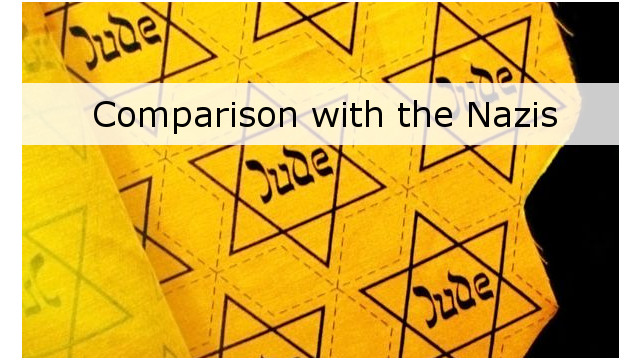Antisemitism: The Israel – Nazi Comparison
 Nazism is the epitome of evil. It’s not suprising that people gravitate to it in hyperbole. Godwin’s Rule of Nazi Analogies, an observation about online discussion, holds that “As an online discussion grows longer, the probability of a comparison involving Nazis or Hitler approaches 1” (that is to say it will happen in any discussion eventually). Godwin himself has said of the rule that, “Although [it is] deliberately framed as if it were a law of nature or of mathematics, its purpose has always been rhetorical and pedagogical: I wanted folks who glibly compared someone else to Hitler or to Nazis to think a bit harder about the Holocaust”. This highlights one major problem with the inappropriate use of comparisons to Nazism; they trivialise the reality of the Holocaust.
Nazism is the epitome of evil. It’s not suprising that people gravitate to it in hyperbole. Godwin’s Rule of Nazi Analogies, an observation about online discussion, holds that “As an online discussion grows longer, the probability of a comparison involving Nazis or Hitler approaches 1” (that is to say it will happen in any discussion eventually). Godwin himself has said of the rule that, “Although [it is] deliberately framed as if it were a law of nature or of mathematics, its purpose has always been rhetorical and pedagogical: I wanted folks who glibly compared someone else to Hitler or to Nazis to think a bit harder about the Holocaust”. This highlights one major problem with the inappropriate use of comparisons to Nazism; they trivialise the reality of the Holocaust.
What the Nazis did was far beyond other genocides (like Darfur). The Palestinian-Israeli conflict, even at its worst, doesn’t come close. The Nazis created an industrialised system to wipe out every last Jew. They moved people across Europe by train just to kill them more efficiently. The horror of the Holocaust goes far deeper than the fact a lot of people died.

When used in the context of Jews or Israel, it’s not just a really poor comparison; its use is designed to cause distress to those who survived the Holocaust or who grew up as the children of survivors. It’s like disagreeing with someone eating meat, and knowing they are a rape victim, choosing to make your point by comparing eating meat with rape and saying that someone who had been raped should know better. It’s not just a bad analogy, it’s applying a different standard to someone because they are a victim, making them a victim a second time.
Professor Yehuda Bauer is a leading expert on the Holocaust and the person who gave the address at the UN General Assembly’s first International Holocaust Remembrance Day commemoration (in 2006). He has noted the uniqueness of the Holocaust, saying that while it is important to compare the Holocaust to other genocides, in doing so one must mention that the Holocaust involved the creation of an industry to manufacture corpses. This is what makes it unique in human history. He explains that genocide occurs when one party is overwhelmingly powerful, and the targeted victim is nearly or totally powerless. He says “the Palestinians cannot overcome Israel with terrorism or rockets, nor can Israel annihilate the Palestinian population; it remains a bloody and difficult conflict, but not a genocide.” Please do read his paper.
The Working Definition of Antisemitism gives as one example of antisemitism “Drawing comparisons of contemporary Israeli policy to that of the Nazis”. The definition was created in 2004 by the European Union Monitoring Centre on Racism and Xenophobia (EUMC), now known as the Fundamental Rights Agency of the European Union. It has received widespread international use, for example in its adopted by the US Government for the State Department Report on antisemitism, and in its adoption by the British Police as part of their Hate Crimes Operations Guide. The London Declaration of the Inter-Parliamentary Coalition to Combat Antisemitism, signed by members of Parliament from around the world, including Australia, also adopts the Working Definition and encourages its widespread use.
There are plenty of ways describe something as bad. There is no need to make a poor analogy by invoking the Holocaust. To do so specifically because the target is Jewish, or the Jewish state (i.e. Israel), is to use that identity as grounds for attacking. That is almost a definition of racism; using someone’s identity as a basis to attack them. Comparing Israeli policy to that of the Nazis, calling Israel a Nazi state, or saying Jews should know better and not behave like Nazis are all forms of the same racist attack. This needs to be called out.

